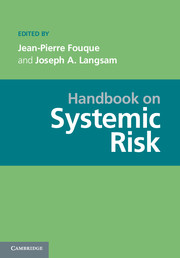Book contents
- Frontmatter
- Contents
- Contributors
- Introduction
- PART I DATA: THE PREREQUISITE FOR MANAGING SYSTEMIC RISK
- PART II STATISTICS AND SYSTEMIC RISK
- PART III MEASURING AND REGULATING SYSTEMIC RISK
- PART IV NETWORKS
- PART V SYSTEMIC RISK ANDMATHEMATICAL FINANCE
- PART VI COUNTERPARTY RISK AND SYSTEMIC RISK
- PART VII ALGORITHMIC TRADING
- PART VIII BEHAVIORAL FINANCE: THE PSYCHOLOGICAL DIMENSION OF SYSTEMIC RISK
- PART IX REGULATION
- PART X COMPUTATIONAL ISSUES AND REQUIREMENTS
- PART XI ACCOUNTING ISSUES
PART VI - COUNTERPARTY RISK AND SYSTEMIC RISK
Published online by Cambridge University Press: 05 June 2013
- Frontmatter
- Contents
- Contributors
- Introduction
- PART I DATA: THE PREREQUISITE FOR MANAGING SYSTEMIC RISK
- PART II STATISTICS AND SYSTEMIC RISK
- PART III MEASURING AND REGULATING SYSTEMIC RISK
- PART IV NETWORKS
- PART V SYSTEMIC RISK ANDMATHEMATICAL FINANCE
- PART VI COUNTERPARTY RISK AND SYSTEMIC RISK
- PART VII ALGORITHMIC TRADING
- PART VIII BEHAVIORAL FINANCE: THE PSYCHOLOGICAL DIMENSION OF SYSTEMIC RISK
- PART IX REGULATION
- PART X COMPUTATIONAL ISSUES AND REQUIREMENTS
- PART XI ACCOUNTING ISSUES
Summary
Introduction
Counterparty Risk and Systemic Risk
Over-the-counter (OTC) derivatives are contracts that are privately negotiated and traded directly between two parties. Securities such as swaps, forward rate agreements, and exotic options are typically traded over the counter. The OTC derivative market is the largest market for derivatives, and is largely unregulated. Participants in this market are banks and other relatively sophisticated financial institutions, such as insurance firms, investment companies, and hedge funds. OTC investors tend to be unaware of recent transactions prices and prices that may be currently available in the market. Thus, OTC markets are relatively intransparent.
The outstanding volume of OTC derivatives has grown exponentially over the past two decades, with only a relatively modest slump during the crisis of 2007–09. According to the Bank for International Settlements, the total outstanding notional amount is US$ 601 trillion (as of December 2010). Of this amount, 77% are interest rate contracts, 10% are foreign exchange contracts, 5% are credit default swaps, 1% are equity contracts, 0.5% are commodity contracts, and 6.5% are other.
Derivatives facilitate the sharing of risk among market participants. They also create connections between market participants. One of these connections is counterparty risk. This is the distribution of loss faced by one OTC derivative party due to the other's failure to perform on its contractual obligations. Unlike many other financial risks, counterparty risk is bilateral: both parties to a contract may be exposed, depending on the value of the positions they hold against each other.
- Type
- Chapter
- Information
- Handbook on Systemic Risk , pp. 481 - 484Publisher: Cambridge University PressPrint publication year: 2013

